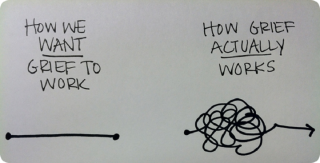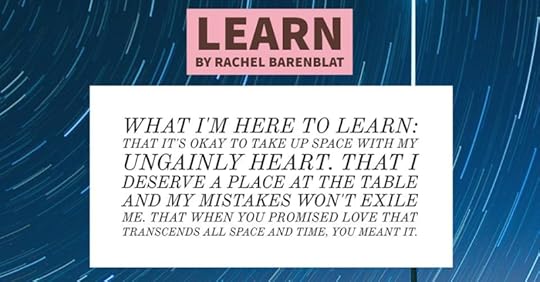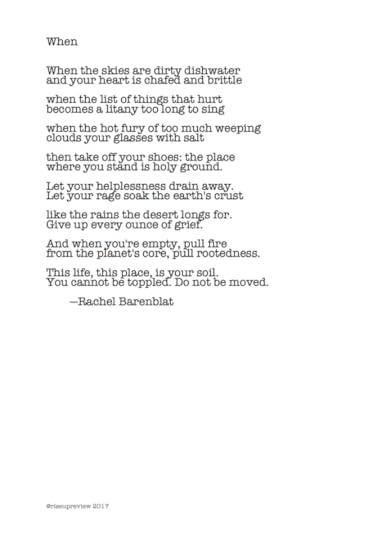Rachel Barenblat's Blog, page 90
March 22, 2017
On divorce and ambiguous loss
"I think this might speak to you," said my friend Cate as she sent me a link to The Myth of Closure, a July 2016 episode of On Being featuring Dr. Pauline Boss. In interviewer Krista Tippett's words, the episode explores "complicated grief, the myth of closure, and learning to hold the losses in our midst." (Cate was right: the episode does speak to me, deeply.)
Pauline Boss is an expert on what's sometimes called ambiguous loss -- for instance, the loss someone feels when a loved one is slowly dying of Alzheimer's. Or the loss experienced by a parent whose child dies, or someone whose loved one is kidnapped and never found. Loss without closure. (One of the cases she makes, quite cogently I think, is that "closure" is a myth that doesn't actually help us.)
She talks about people grieving loved ones who died in dramatic ways: the 9/11 terrorist attacks, or a tsunami that kills thousands. Those parts of the interview are powerful... but for me the most resonant sections are when she's talking about ordinary losses. For instance, she talks about how American culture expects immigrants to not grieve their decision to leave wherever they came from. And she says:
The more you want people to get over it, the longer it will take for them. And why not remember your former country, your former island, your former culture while you’re learning to fit into the new one? In other words, having two cultures is what it ends up being.
What she says here makes me think of my own life changes, especially the end of my marriage. The life we had been building is the "country" that I left, to which I can't return. I have complicated feelings when I remember the home I used to know -- not so much the literal house where we lived (though I miss that sometimes too), but the psycho-spiritual sense of home that I located in that relationship.
We all go through these changes, and we all experience this kind of loss. "The past is a foreign country," as L.P. Hartley wrote. None of us can revisit what was. Even in a relationship that remains intact, we can't go back to how things were then, whenever "then" was. But in a relationship that comes apart, the sense of loss is more profound... and one can't help remembering what was, even when it is no more.
I'm not the only one who makes the leap between the ambiguous loss inherent in literal immigration and the ambiguous loss inherent in this more metaphorical kind of move between life's chapters or incarnations. At one point in the episode, Krista asks Dr. Boss to reflect specifically on how these ideas about complicated grief and the fantasy of closure relate to divorce. And Dr. Boss says:
"[C]losure” is a terrible word in human relationships. Once you’ve become attached to somebody, love them, care about them, when they’re lost, you still care about them. It’s different. It’s a different dimension. But you can’t just turn it off...
it’s not as dramatic as the disasters we are talking about, but it’s more common every day. And that is you are leaving someone, you have lost someone by the divorce certificate, but they’re still here. So they’re here, but not here...
[T]hey’re present and also absent at the same time. That’s especially true when you co-parent children. And so divorce is a kind of human relationship that is ruptured but not gone.
Ruptured but not gone: that feels familiar to me. Once you've been attached to someone in a deep and intimate way, that attachment can't be erased. It becomes part of who you are. (Rabbi Alan Lew wrote about this too, in his brilliant This Is Real And You Are Completely Unprepared, which I have cited here so often over the years.) Even when the marriage is over, it remains, like a phantom limb.
In one sense, divorce is real, and it makes a difference. The ritual that ended my marriage was real, and it made a difference. And in another sense, divorce is a fiction -- or at least "closure" is a fiction. Even when one or both partners move on with their romantic and interpersonal lives, the relationship that was never entirely disappears. It is always something that used to exist, and its imprint remains.
And loss and grief are not linear experiences. It's easy and tempting to imagine that one goes from greatest grief, to lesser grief, to no grief at all. That would be so logical, wouldn't it? And that isn't how life works. Grief comes and goes on its own calendar, in its own ways. (I've written about that before -- see Good Grief, 2014.) And grief can coexist with gratitude and hope. They don't cancel each other out.
Getting divorced is an ongoing experience of coming to terms with ambiguity. I can be thriving in every way -- and then be knocked into a spiral of sorrow by the sound of a particular song, or the sight of two people holding hands, or a wedding invitation that arrives in the mail. The grief doesn't negate the truth that I am thriving, and the thriving doesn't negate the truth that I am still navigating grief.
Getting divorced is an ongoing experience of coming to terms with contradictory truths. I was partnered for 23 years, and now I'm navigating life without a companion. I'm grateful for what is, and sad for what isn't. The relationship through which I once self-defined no longer exists, but it will always have existed, and I will always be shaped by it, even as I work on learning to define myself in other ways.
There's ambiguity in all of these things. And my relationship to the marriage, and to the feelings of loss that still ebb and flow as I approach the one-year anniversary of the day when we agreed that the marriage was over, is also ambiguous. I'm grateful and I'm sad at the same time. In one way the marriage is long over, and in another way the marriage will never stop shaping who I become.
Deep thanks to Krista Tippett and to Dr. Pauline Boss for giving me a conceptual frame big enough to hold these ambiguities. Listen to the episode or read the transcript here: On Being: The Myth of Closure.

March 21, 2017
Book news!
I'm delighted to be able to announce this happy news: Ben Yehuda Press will be publishing my next collection of poems, Texts to the Holy!
Many of the poems from Texts to the Holy have appeared on this blog over the last few years. It is my collection of love poems to the Beloved, and I am so excited that it will see print.
Ben Yehuda published my most recent collection, Open My Lips, in 2016. You can find all of their poetry collections on their website -- celebrate World Poetry Day by supporting independent poetry publishing!
(And while you're at it, please support Phoenicia Publishing, too -- they published my first two collections, and they've published some amazing work since.)

March 20, 2017
Poem at The Rise Up Review
I'm honored to be today's featured poet at The Rise Up Review. The poem of mine that they're featuring today is the first poem I wrote during 2017:
Here's the page containing my poem and bio; here's the index page, currently listing all featured poets during the month of March; and here's the archive of back issues.
I'm grateful to the editors for choosing to highlight my work, and for their holy work of midwifing more poetry into the world.

March 14, 2017
New at Ritualwell: When Jews and Muslims Pray Together
"I'm deeply distressed at the desecration of Jewish cemeteries," said my colleague Sharif at the weekly chaplains' staff meeting at our small liberal arts college.
"I'm deeply distressed by the mosques set afire," I said to him in return.
We both find hope in stories of interfaith solidarity across what can be a contentious divide between the children of Ismail and the children of Yitzchak. We've read about Muslims raising money to repair Jewish tombstones, and Jews raising money to refurbish torched mosques, and we take heart from those things.
But what could we do on our little campus to foster that spirit of interfaith solidarity and to bring comfort to two minority religious communities whose members are likely sad and anxious about bomb threats at JCCs and reports of rising Islamophobia?
The answer turned out to be powerful and simple: pray in each others' religious spaces, with and for each other...
Read the whole piece at Ritualwell: When Jews and Muslims Pray Together.
Thanks to the editors at Ritualwell for publishing the piece, and deep thanks to the interfaith comunity at Williams for so beautifully and bravely standing together.

March 13, 2017
God says yes
I will keep
company with you
where you go
I will go
when bitter exile
narrows your horizon
your tight straits
will be mine too
let me lift you
from the ashes,
dress you in
nothing but light
like a new mother,
breasts over-full
I ache to spill
blessings for you
let me carry you
through foaming seas
come undone with me
on the far shore
I will keep / company with you[.] One of my favorite names for God is the One Who accompanies, who keeps us company in whatever life brings.
where you go / I will go[.] See Ruth 1:16.
bitter exile... tight straits[.] Jewish tradition describes Shekhinah, the immanent / indwelling / feminine Presence of God, going into exile with the Jewish people. This could mean exile in the Diasporic sense, or could mean exile in a more existential sense (exile from unity with God.)
let me lift you / from the ashes and dress you in / nothing but light [.] Both of these couples reference lyrics in Lecha Dodi, a love song to Shabbat which we sing on Friday night
breasts over-full[.] From Talmud, Pesachim 112a: "More than the calf wants to suckle, the cow wants to give milk." I learned this as a teaching about how God yearns to nurture and nourish us. Our prayers prime the pump for the blessing God yearns to bestow.
let me carry you / through foaming seas[.] In daily liturgy we remember the crossing of the Sea of Reeds. I often sing that prayer to the melody of "The Water is Wide," reminding myself that God is with me in all of life's ocean-crossings.
This may or may not be part of my next collection, Texts to the Holy. Where the other poems in that series are love poems spoken in my own voice, this one is in the voice of the Beloved. But even if it doesn't go in the book, I think it's part of the same series / comes from the same emotional-spiritual place.

March 10, 2017
What costumes can reveal
I remember the first time I saw a boy in drag and found him beautiful. It was fall of my freshman year. My first boyfriend lived in the entry next to mine, and he dressed in my clothes for a dance party thrown in Currier Ballroom by the organization that was then called the BGLU. He fit easily into my purple suede miniskirt and blue silk shirt. I made up his face the way I had learned to make up my own. And when his transformation was complete, he was gorgeous.
That I found him equally attractive when he presented as a femme man, and when he presented as a butch woman, was revelatory for me. (Those phrases sound binaristic now, but that was the language we used then.) That was my first step toward recognizing that the qualities that draw me -- intelligence, kindness, musicality, integrity -- aren't gender-specific. My boyfriend dressed in a costume that hid his everyday identity, and seeing him in that guise taught me something about myself.
Purim, which begins tomorrow night, is a holiday of masks and costumes. Everywhere around the Jewish world, people will wear costumes and veils, masks and disguises. Some of our costumes will be silly, or funny. Some will be random. Some will enable us to show sides of ourselves we don't usually get to display. Regardless: the act of putting on a costume invites us to think about the masks we wear every day, and in turn about what it would feel like to set those masks aside.
We all wear masks in daily life. Maybe we hide our vulnerability. Maybe we hide our yearnings. Here in this environment most of us don't feel the need to hide our intelligence -- intellect is valued here -- but we may feel the need to hide our hearts. We may hide a love interest we fear is unrequited, or compassion we don't feel safe expressing aloud. We may hide our strength. We may hide emotions that we learned, in childhood, it wasn't safe for us to manifest or express: fear, or anger, or joy.
The hero of the Purim story is Esther, whose name shares a root with נסתר / nistar, hidden. When Esther enters the palace of Achashverosh, on Mordechai's advice she hides her Jewishness. It's a lie of omission. She just... doesn't mention that part of who she is. Until, of course, the time comes when the only way she can save her community is to come out as a Jew and hope that Achashverosh's attachment to her will extend far enough to save her people too. Esther's willingness to stop hiding saves the day.
There's another figure in the megillah of Esther who's hidden, and that's God. God doesn't appear in this book at all -- at least not overtly. God's name is never mentioned. But our mystics tell us that God isn't absent; only נסתר, hidden. In our lives, too, divine presence may be hidden. But if we search for divinity, we can experience God everywhere: not just in the spaces that look holy, like Shabbat services, but also in spaces that might appear secular or profane, like costume parties or a drag ball.
God's hiddenness, coming out, and drag balls: this d'varling may not be in everyone's comfort zone. (Maybe it's the drag that's uncomfortable for you; maybe it's the God-language.) I want to sit with that -- not flinch from it, not hide it, but embrace it. Because to say that God can be נסתר (hidden) is to say that we find God where we least expect to... including in and through our own spiritual discomfort.
What are the things you habitually feel the need to hide? What would it feel like to have the safety to be your whole self -- not hiding, not silenced, not compartmentalized, but bringing all of who you are to every moment of your life? What would it feel like to recognize that you are a reflection of the Holy One of Blessing, made in the image and the likeness of God, not despite the things you usually tend to hide but precisely and absolutely in all of who you are?
The Esther story reminds us that there's a time for hiding, and a time for revealing. May we continually keep learning more deeply who we are and who we're becoming: when we choose to conceal ourselves, and when we choose to try on different faces, and when we choose to reveal our splendor and our light. May we be safe -- physically, emotionally, intellectually, spiritually -- when we veil and when we unveil, this Purim and always.
This is the d'varling I offered tonight at the end of Kabbalat Shabbat services at the Williams College Jewish Association.

March 7, 2017
On cultivating joy as Purim approaches - in The Wisdom Daily
...What role does joy play in spiritual life? Some might claim that it’s a distraction from spiritual life, but that’s not the Jewish way. The psalms instruct us to serve God with joy (Psalm 100:2). The Talmud tells us that this is meant to be a joyful season of our year. And the sage known as the Baal Shem Tov (Rabbi Yisrael ben Eliezer, d. 1760) taught that we should work to discern what’s good and joyful within every experience life gives us.
Others might say that joy is the end result of spiritual life, but what then do we make of the fact that we all have moments in our lives that are not joyful? If we’re feeling sorrow or grief, does that mean that we’re “failing” at being spiritual? (Hardly: it means we’re succeeding at being authentic to where we are.)
“When Adar enters, joy increases” is a common translation of the Talmudic dictum with which I began, but it misses one subtlety in the original. The original is closer to, “When Adar enters, we increase joy.” There’s a presumed actor or set of actors there. Joy doesn’t increase on its own; someone has to do something in order for joy to increase....
That's from my latest at The Wisdom Daily. Read the whole thing: Purim Reminds Us That Cultivating Joy Is An Important Spiritual Tool.

March 6, 2017
Stop hiding: let yourself go free
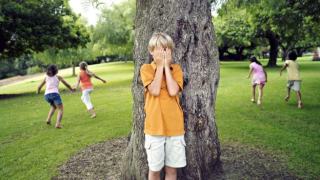 The festival of Purim (coming up this Saturday) is a holiday of concealment. At Purim we read the Scroll of Esther, a delightfully bawdy Persian court soap opera which doesn't appear, at first glance, to have much to do with spiritual life or with God. Jewish tradition doesn't shy away from this oddity -- we embrace it and find meaning in it.
The festival of Purim (coming up this Saturday) is a holiday of concealment. At Purim we read the Scroll of Esther, a delightfully bawdy Persian court soap opera which doesn't appear, at first glance, to have much to do with spiritual life or with God. Jewish tradition doesn't shy away from this oddity -- we embrace it and find meaning in it.
The quintessential act of Purim is להתחפש, a reflexive verb which means to dress oneself up or to conceal oneself. We do this when we dress up in costumes on Purim. Esther does this when she hides her Jewishness (until the moment comes for her to reveal herself and in so doing save the day). God does this in concealing God's-self entirely; God is never even mentioned in the megillah (though to the discerning eye God's presence may be subtly manifest even so.)
Purim is about the self-reflexive act of hiding. But what happens when we shift that verb and make it no longer reflexive? We get the verb לחפש - to search. And searching is one of the quintessential moves we make before Pesach. On the night before Passover begins, there's a tradition of lighting a candle and searching our homes for "hidden" hametz (leaven), a physical hide-and-seek game that represents a deeper inner searching. We read in the book of Proverbs (20:27) that our own souls are God's candle -- just as we search for hidden leaven by the light of a physical candle, God uses our souls as candles to illuminate all that's hidden in the world.
When we search for hametz, we're not just looking for bread crusts. We're also seeking spiritual leaven, the puffery of pride and ego, the sour old stuff within us which needs to be discarded in order for us to move toward freedom.
The shift from להתחפש to לחפש, from concealment to searching, is the fundamental move we're called to make as spring unfolds, as we move from Purim (festival of masks and concealment) to Passover (festival of searching and liberation). At Purim, we may be hiding -- from others, and even from ourselves. Maybe it feels dangerous to let ourselves be known. Maybe there are truths we don't want to admit. Maybe we think there are parts of ourselves we have to hide in order to move freely in the world. Maybe we think we are better off if we conceal the parts of ourselves of which we are ashamed, or the parts of ourselves which don't meet others' expectations.
But in order to move toward freedom, we have to turn the reflexive verb outward: we have to move from hiding (from) ourselves to searching for what's been hidden. If God hides in order that we might seek, then it stands to reason that so do we. We have to unearth precisely our own stuff which we have hidden from the world. We have to unearth precisely our own stuff which we have hidden even from ourselves. The hopes and yearnings that we've tried to keep under wraps, the sorrows and fears that we've tried to hide, from others and from ourselves.
May we do that unearthing through therapy, or hashpa'ah (spiritual direction), or a writing practice, or a prayer practice. Maybe we do that unearthing through conversations with a trusted friend who can help us see ourselves more clearly than we could see on our own. Maybe we do that unearthing through studying texts and delving into the passages that resonate with us. There are many ways to do the work of searching for who we really are. What's important is that we light the candle and we do the searching. Passover will come in the fullness of time no matter what, but the journey of the Exodus will mean more if we're willing to do this inner work.
The hametz we need to root out is not our imperfections (because everyone is imperfect) but the way we try to hide our imperfections, the way we shame ourselves for our imperfections. The internal narrative which says that we are only lovable, or only worthwhile, if we keep parts of ourselves -- our quirks, our mistakes, our tenderest places -- hidden. The need to conceal oneself can become a kind of Mitzrayim, a place of constriction. In order to emerge from the tight places in our lives, we need to stop hiding. We need to move from concealing ourselves to searching for ourselves in order to let ourselves go free.
And the journey takes us one step further. We move from concealment (Purim) to searching (Pesach) to revelation (Shavuot.) Purim's reflexivity primes that pump: first we own (and prepare to relinquish) our own hiding. Then we search for our deepest truths and begin to experience the freedom of wholly being who we truly are. Only then can we be ready to receive revelation anew. The journey to revelation begins right now. The places where we've hidden our hearts from others or from ourselves aren't impediments to the journey: they are the spark that will ignite the inner spiritual journey of our transformation.
Dedicated to Rabbi David Evan Markus, from whom I learned this teaching.
Image: hide-and-seek, from the BBC.

March 4, 2017
Face to face
 This week's Torah portion, Terumah, contains exquisitely detailed instructions for the building of the mishkan, the portable dwelling-place for God that our ancestors created in the wilderness. But there's one element in the design that is intriguingly vague: the instruction to place two kruvim atop the ark.
This week's Torah portion, Terumah, contains exquisitely detailed instructions for the building of the mishkan, the portable dwelling-place for God that our ancestors created in the wilderness. But there's one element in the design that is intriguingly vague: the instruction to place two kruvim atop the ark.
It's possible that our Biblical forebears knew what kruvim looked like, so Torah didn't feel the need to offer blueprints. And it's possible that the kruvim were ineffable even then.
All we know is that they are made of gold, and they have wings, and they face each other. Well, in this week's Torah portion they face each other. In the book of Chronicles we read that when the Temple was built, the kruvim faced the Temple, not each other.
Given these two disparate descriptions, our sages decided that the kruvim had a mystical ability to move in imitation of us. When we in the community follow the mitzvot and treat each other lovingly, then the kruvim face each other in I/Thou relationship, as do we. When we reject the mitzvot and treat each other dishonorably, then the kruvim turn away from each other, as we have turned away from each other and from God. The keruvim become our mirror.
I had the opportunity recently to study a short text from the Aish Kodesh, a collection of teachings by Rabbi Kalonymus Kalman Shapira who was the rabbi in the Warsaw Ghetto. He writes that when we stand before God in prayer, when we speak to God as a "you" (in Martin Buber's language, a "thou"), we draw forth that aspect of God with Whom we can be in relationship. When we do that, we find God's presence in the act of prayer -- or maybe we find our own presence, our own deepest selves revealed to us.
We read in Proverbs that כַּמַּיִם, הַפָּנִים לַפָּנִים כֵּן לֵב-הָאָדָם לָאָדָם: just as water reflects our faces back to us, so our hearts can reflect us to each other. When I connect to you as a "thou," I see myself reflected in your heart. When I connect to God a a "thou," my yearning calls forth divine presence, and I see myself reflected in the Divine. Because I seek, God becomes revealed -- and so do I. God becomes the mirror in which I see my deepest self most fully.
And that brings me back to the kruvim in this week's Torah portion, which are also a kind of mirror. When we yearn for connection, and act out of that yearning, they face each other in mirror image. When we lose sight of our yearning for God, our yearning for connection and holiness, our yearning for sanctified relationship, the mirroring goes away. They no longer face each other, as we and God no longer face each other, and we lose the mirror in which we might have seen ourselves and God more deeply.
Spiritual life is a journey of constant rising and falling, waking and falling asleep, trying and failing and trying again. We strive to be the best people we can be. Then we notice that we've lost track of our best intentions. Then we turn ourselves around to try again. That existential act of turning ourselves around to try again is what our tradition calls teshuvah, repentance or return.
Making teshuvah is our perennial task -- not only during Elul and the Days of Awe (though we talk a lot about teshuvah at that season) but always. We can make teshuvah each week before Shabbat, and each night before sleep. It's our task to notice where we've fallen away and to turn back: to re-enter into relationship with the tradition and with our fellow human beings and with God.
When we turn to face each other, there's the potential for experiencing God's presence in the space between us, the relational space, the I/Thou space, like the relational space between the kruvim of old from which God's voice was said to issue forth. When we turn to face God, we prime the pump for revelation -- and whether it's revelation of God's self, or revelation of our own deepest self, doesn't really matter. Either way, we open the door to our own transformation.
This is the d'var Torah I offered at CBI this morning (cross-posted to my From the Rabbi blog.)
Related:
Gaze, a poem that draws on these teachings from the Aish Kodesh, 2017
The Space Between, about the kruvim and God's voice issuing forth from between them, 2016

March 3, 2017
Dwelling in us
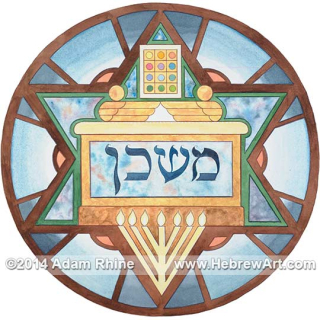 This week's Torah portion, Terumah, contains one of my favorite verses in Torah: ועשו לי מקדש ושכנתי בתוכם -- usually translated as "Let them make for Me a sanctuary, that I might dwell in their midst." It comes as part of the instructions for building the mishkan, the portable tabernacle that our ancestors were instructed to build and to carry in the wilderness.
This week's Torah portion, Terumah, contains one of my favorite verses in Torah: ועשו לי מקדש ושכנתי בתוכם -- usually translated as "Let them make for Me a sanctuary, that I might dwell in their midst." It comes as part of the instructions for building the mishkan, the portable tabernacle that our ancestors were instructed to build and to carry in the wilderness.
The word mishkan shares a root with the word Shekhinah, the name that our mystics gave to the immanent, indwelling Presence of God. They imagined a transcendent aspect of God, "up there," far away, unreachable, inconceivable -- and an immanent aspect of God, "down here," in creation, as close to us as the beating of our own hearts. Some would say that the mishkan was the house our ancestors built for Shekhinah -- the place where God's presence could dwell.
It was portable, with rings built into the sides and poles that went into the rings, so it could be carried in the wilderness. That teaches us that we can carry God with us wherever we go. I like that idea of the portability of spiritual practice. We don't have to come to a special place in order to have spiritual lives, even though it's nice to have a special place as beautiful as this one! We carry our spiritual lives with us. That really works for me.
And... going back to that verse from Torah with which I began, I want to offer a different translation that changes the meaning in a subtle but important way.
I like to read ועשו לי מקדש ושכנתי בתוכם as "Let them make for Me a holy place, that I might dwell within them." The word בתוכם can mean either "in their midst" or "within them," and I prefer the latter. When I read it that way, it tells me that when we build structures for holiness in our lives, then God dwells in us.
When we take the time to make Shabbat special and separate from the workweek, God dwells in us. When we take the time to feel our inner sap rising at Tu BiShvat, or to celebrate the topsy-turviness of how costumes can both conceal us and reveal us at Purim, God dwells in us. When we retell the story of our liberation at Pesach, and reflect on the meanings of liberation in our own lives, God dwells in us. When we make a blessing before we eat, or say the shema before falling asleep, or murmur a prayer for gratitude upon waking, God dwells in us.
These are all explicitly Jewish acts, but I think this teaching has wisdom to offer us as human beings, not "just" as Jews. What if we could live with the intention that when we approach each moment with mindfulness, God dwells in us? How might that change our sense of everyday life?
Try this on: when we are true to who we most deeply are, God dwells in us. When we treat each other with respect, God dwells in us. When we live with integrity, God dwells in us. When we seek meaning in our lives, God dwells in us.
The ultimate source of meaning, and wisdom, and love, isn't just "out there" somewhere: it's also "in here," in our own hearts. Our whole lives can be the structures within which holiness can dwell.
This is the d'varling I offered at WCJA at Kabbalat Shabbat this week. Image by Adam Rhine.

Rachel Barenblat's Blog
- Rachel Barenblat's profile
- 6 followers


